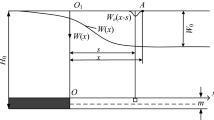Abstract
Due to the inability of the single line of sight D-InSAR to monitor the three-dimensional deformation of the surface, the conventional methods are unable to obtain the prediction parameters (probability integral parameters) of surface subsidence in coal mining. In this paper, a calculation method of simulated annealing (SA) for probability integral parameters based on single line of sight D-InSAR is proposed. Firstly, the method predicts the subsidence, the horizontal movement in the north–south direction and the horizontal movement in the east–west direction of the target pixel by using the probability integral method. Based on the projection relationship between the three-dimensional deformation and the LOS deformation, the predicted movement and deformation of the target pixel in LOS direction (\(r_{{i{\text{LOS}}}}^{'}\)) are calculated. Using the measured movement and deformation of the target pixel in LOS direction (\(r_{{i{\text{LOS}}}}\)), the residuals of the target pixel are calculated (\(v_{i} = r_{{i{\text{LOS}}}} - r_{{i{\text{LOS}}}}^{'}\)) and the error function of the parameter is constructed (\(\varepsilon (B) = \sum {|v_{i} |}\)). Then based on the criteria (\(\varepsilon (B) = \hbox{min}\)), all the probability integral parameters are obtained accurately by the SA method. The accuracy and robustness of the proposed method are verified by simulation experiments. At last, the predicted parameters of mining subsidence in 9310 working face of Nantun Coal Mine are calculated by this method, and the characteristics of probability integral parameters are analyzed.








Similar content being viewed by others
References
Bányai L, Szűcs E, Wesztergom V (2016) Geometric features of LOS data derived by SAR PSI technologies and the three-dimensional data fusion. Acta Geod Geoph 52(3):421–436
Catalao J, Nico G, Hanssen R et al (2011) Merging GPS and atmospherically corrected InSAR data to map 3-D terrain displacement velocity. IEEE Trans Geosci Remote Sens 49(6):2354–2360
Du Y, Zhang L, Feng G et al (2017) On the accuracy of topographic residuals retrieved by MTInSAR. IEEE Trans Geosci Remote Sens 99:1–13
Fan H, Gao X, Yang J et al (2015a) Monitoring mining subsidence using a combination of phase-stacking and offset-tracking methods. Remote Sens 7(7):9166–9183
Fan HD, Cheng D, Deng KZ et al (2015b) Subsidence monitoring using D-InSAR and probability integral prediction modelling in deep mining areas. Surv Rev 47(345):438–445
Fialko Y, Sandwell D, Simons M et al (2005) Three-dimensional deformation caused by the Bam, Iran, earthquake and the origin of shallow slip deficit. Nature 435:295–299
Gisinger C, Balss U, Pail R et al (2015) Precise three-dimensional stereo localization of corner reflectors and persistent scatterers with TerraSAR-X. IEEE Trans Geosci Remote Sens 53(4):1782–1802
Gourmelen N, Kim SW, Shepherd A et al (2011) Ice velocity determined using conventional and multiple-aperture InSAR. Earth Planet Sci Lett 307(1):156–160
Gray L (2011) Using multiple RADARSAT InSAR pairs to estimate a full three-dimensional solution for glacial ice movement. Geophys Res Lett 38(38):132–140
Gudmundsson S, Sigmundsson F, Carstensen JM (2002) Three-dimensional surface motion maps estimated from combined interferometric synthetic aperture radar and GPS data. J Geophys Res Solid Earth 107(B10):ETG 13-1–ETG 13-14
Guglielmino F, Bonforte A, Puglisi G et al (2011) Analysis of satellite and in situ ground deformation data integrated by the SISTEM approach: the April 3, 2010 earthquake along the Pernicana fault (Mt. Etna-Italy) case study. EGU Gen Assem 2011:327–336
He L, Wu L, Liu S et al (2015) Mapping two-dimensional deformation field time-series of large slope by coupling DInSAR-SBAS with MAI-SBAS. Remote Sens 7(9):12440–12458
Hu J (2012) Theory and method of three-dimensional deformation estimation based on modern surveying adjustment. School of Earth Science and Information Physics, Central South University, Changsha
Hu J, Li ZW, Zhu JJ et al (2010) Inferring three-dimensional surface displacement field by combining SAR interferometric phase and amplitude information of ascending and descending orbits. Sci China (Earth Sci) 53(4):550–560
Hu J, Ding XL, Li ZW et al (2013) Kalman-filter-based approach for multisensor, multitrack, and multitemporal InSAR. IEEE Trans Geosci Remote Sens 51(7):4226–4239
Hu J, Li ZW, Li J et al (2014) 3-D movement mapping of the alpine glacier in Qinghai-Tibetan Plateau by integrating D-InSAR, MAI and offset-tracking: case study of the Dongkemadi Glacier. Global Planet Change 118(4):62–68
Jung HS, Lu Z, Won JS et al (2011) Mapping three-dimensional surface deformation by combining multiple-aperture interferometry and conventional interferometry: application to the June 2007 Eruption of Kilauea Volcano, Hawaii. IEEE Geosci Remote Sens Lett 8(1):34–38
Li ZW, Yang ZF, Zhu JJ et al (2015) Retrieving three-dimensional displacement fields of mining areas from a single InSAR pair. J Geodesy 89(1):17–32
Samsonov S, Tiampo K (2006) Analytical optimization of a DInSAR and GPS dataset for derivation of three-dimensional surface motion. IEEE Geosci Remote Sens Lett 3(1):107–111
Samsonov S, D’Oreye N, Smets B (2013) Ground deformation associated with post-mining activity at the French–German border revealed by novel InSAR time series method. Int J Appl Earth Obs Geoinf 23(8):142–154
Wang K, Gao X, Chen T (2008) Influencing factors for formation of urban and rural spatial structure in metropolis fringe area taking Shuangliu County of Chengdu in China as a Case. Chin Geogra Sci 18(3):224–234
Wright TJ, Parsons BE, Lu Z (2004) Toward mapping surface deformation in three dimensions using InSAR. Geophys Res Lett 31(1):169–178
Zhao R, Li ZW, Feng GC et al (2016) Monitoring surface deformation over permafrost with an improved SBAS-InSAR algorithm: with emphasis on climatic factors modeling. Remote Sens Environ 184:276–287
Acknowledgements
The work was supported by the National Natural Science Foundation of China (Grant numbers 41602357,41474026), Anhui Province Postdoctoral Fund (Grant number 2014B019); Anhui University Natural Science Research Project (Grant number KJ2016A190); The Key Laboratory of the Ministry and Province foster an open fund base of mine disaster prevention (Grant number MDPC2013KF14).
Author information
Authors and Affiliations
Corresponding authors
Rights and permissions
About this article
Cite this article
Wang, L., Li, N., Zhang, Xn. et al. Full parameters inversion model for mining subsidence prediction using simulated annealing based on single line of sight D-InSAR. Environ Earth Sci 77, 161 (2018). https://doi.org/10.1007/s12665-018-7355-0
Received:
Accepted:
Published:
DOI: https://doi.org/10.1007/s12665-018-7355-0




